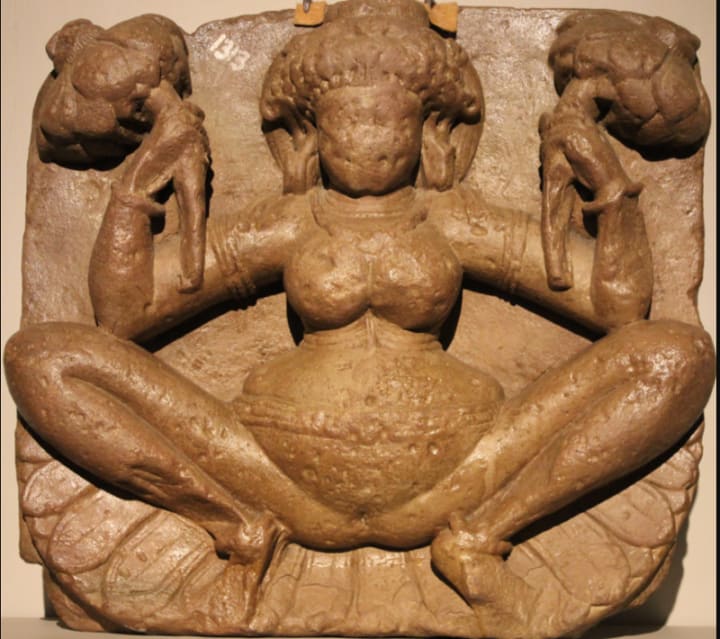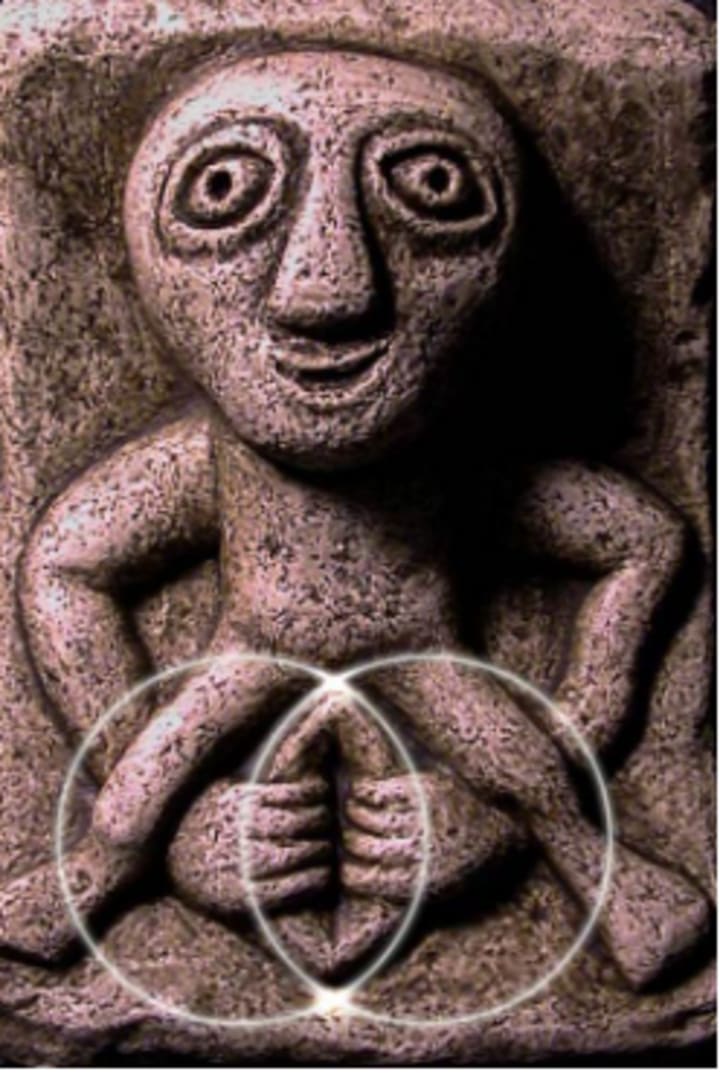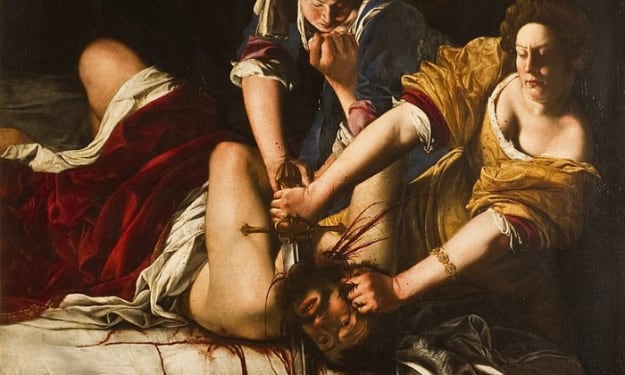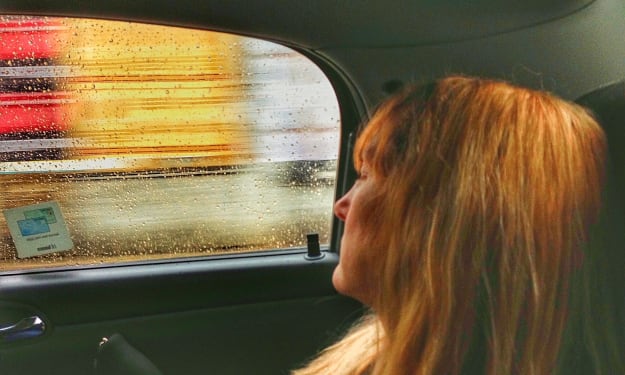The Mysterious Genital Sculptures That Adorn Britain's Churches
And their feminist interpretations

Sheela Na Gigs are seemingly erotic stone carvings of female figures predominately found in Romanesque churches.
What's special about them? Well these sculptures consist of an old disproportionate woman squatting and pulling apart her vulva, a fairly strange thing to find in a church.
Hidden in plain sight, and often overlooked, or perhaps ignored by vicars and congregations, these figures can be seen across the churches of Ireland, Britain, and even France and Spain.
Their exact beginnings are an enigma but they seem to have originated as early as the 11th century. These carvings can be found on secular buildings too like a stable door in Haddon Hall Derbyshire and various castles in Ireland.
John Harding, Founder of the Sheela Na Gig project, has spent over 20 years tracking down sights of Sheela across Ireland.
He explains, "Sheela is the Irish form of the Norman name Cecile, and 'gig' is actually English slang and it means a woman's bits like genitalia and breasts."
Much has been written and debated about these mysterious stone sculptures and Sheela's unapologetic sexual display has sparked intrigue, shame, and mostly anger. Mid-nineteenth-century censorship laws led to the violent destruction of these sculptures.
Prof Georgia Rhoades who wrote a scholarly article in 2010 said, "We don't have to look at these carvings with just one interpretation." Rather let's look around at all the possible interpretations and see which one seems plausible.
1. An Evil-warding figure
European churches often depict them as grotesque evil warding figures to keep demonic spirits away. The vulva is considered as a gate between life and non-life and the carvings are positioned mostly over doors and windows. Therefore it is understandable that these eerie figurines are intended to turn away harm from the holy structures.
In Church Stretton, in Shropshire, a Sheela na gig sits right above the door where the dead is brought in and out of.
Prof. Rhoades believes that in Church Stretton Sheela is saying that you come out of the earth, you return to the earth, you come out of me and you return to me … You can ignore death as much as you want to, but death is going to come.
2. The Divine Hag
One set of historians argues that Sheela Na Gig represents a pagan goddess, appearing as a lustful hag. The carvings depict facial scars, and a disproportionate body in an explicit manner, thus propounding that this was a way to warn the common people against the sin of lust.
3. An Occult
And for some, Sheela is occulted. Like the one at the Rock of Cashel in Co Tipperary, Ireland, she is hidden at the top of the castle walls. For someone to carve the symbol at such an inaccessible place, there might be a real power embedded in the figure.
Prof. Rhoades recalls meeting a young curator from the National Museum in Dublin a few years ago, who had been asked to do an inventory of the Sheelas the museum holds. But he stated, some of his colleagues were so worried that the Sheela might cause undue arousal in him.
4. Fertility Goddess

Sheela Na Gig has been seen as an embodiment of the cycle of fertility - overarching human procreation and death. In some places, brides are required to look at and seek blessings from Sheela before weddings, suggesting Sheela's role in fertility rites.
Margaret Murray (1923), an Egyptologist was the first researcher to view Sheela Na Gig as a female icon of reverence and goddess of fertility. In her research, she says that Sheela Na Gig is most similar to the Greek female fertility figure Baubo, the companion to the Egyptian queen Isis. In India, the fertility goddess Lajja Gauri is shown in a similar birthing posture.
Across all these representations, secondary sexual characteristics like breasts are minimal. The vulva (in the case of Sheela Na Gig and Baubo) and the womb (in the case of Lajja Gauri) are personified as goddesses.
So this categorization does seem plausible.
Dr. Barbara Freitag, a former lecturer in intercultural studies at Dublin City University and author of the 2004 book Sheela Na Gigs: Unravelling an Enigma, was the first to place academic muscle behind the idea of the Sheela as a goddess or talisman.
She was fascinated by Sheelas in the 1980s when a US academician was forbidden access to some of the areas in the National Museum of Ireland in Dublin.
What could possibly be so frightful, she thought. "And, of course, the prevailing theory at the time was that these were portraying the evil of lust - and that they were put up on churches as warnings - which is absurd." Why? "Because they're so high up," she says. "You'd almost need binoculars to see some of them!"
How 'grotesque' is Sheela Na Gig?

Sheela Na Gig sculpture with Vesica PiscisSheela is called grotesque and the term 'grotesque' is an ancient ornamental style from wall paintings in caves (which means grotte in French). With the evolution of art, history, and culture, this low art became synonymous with the lower part of the body.
The term has lost its reference and today it has become a lens of morals labeling and demeaning art that does not confirm the hegemony. Interestingly, Sheela Na Gig sculptures also depict Vesica Piscis (might be a story for another day).
Thus labeling Sheela Na Gig as grotesque serves no purpose other than subverting the discussion of true origin.
Feminist Interpretations of Sheela Na Gig
There is a story distortion and malignation of these figurative carvings where British colonialists of Ireland viewed the natives as descendants of Africans to rationalize and explain their enslavement. Therefore, even though the Sheela was a part of European culture and history, the colonists used primitive concepts often depicting Africans as hypersexual to explain the sculptures.
Sheela Na Gigs were framed as products of exotic African sexuality instead of treating them as a legacy of Anglo Christians.
Moreover, the academics and research of the early 19th century were mostly male-dominated professions. This lead to the most apparent use of belittling language to describe Sheela Na Gig. Sheela was thus viewed through the eyes of femininity and an off-putting language of disgust while using words like 'hideous', 'grotesque', 'absurd', 'frightful looking was common.
Lastly
For the anonymous women behind Project Sheela, the rediscovery of the history of Sheela might bring a mind shift, especially among the younger generation to choose their own spiritual symbols away from the oppressiveness of the Catholic church.
Sheela Na Gig disrupts the stable bounders of gender, sexuality, and expected standards of female beauty. Her physical characteristics, - the baldness, protruding eyes and tongue, distorted body, and most importantly the large vulva - question the dominant notions of femininity. The maternal figure's gaping vulva portrays a transition between life and non-life.
The lack of textual and verbal records about Sheela - whether destroyed, vanished, or forbidden indicates how misogynist historical interpretations were drawn.
References :
A lot of knowledge in two circles: The Vesica Piscis – Sacred Geometry
Sheela-na-gigs: The naked women adorning Britain's churches
Her Name is Sheela, and She Commands Your Attention
Big vagina energy: the return of the sheela na gig
If you like to view the video version of this article:
About the Creator
Kamna Kirti
Art enthusiast. I engage with art at a deep level. I also share insights about entrepreneurship, founders & nascent technologies.
https://linktr.ee/kamnakirti







Comments
There are no comments for this story
Be the first to respond and start the conversation.